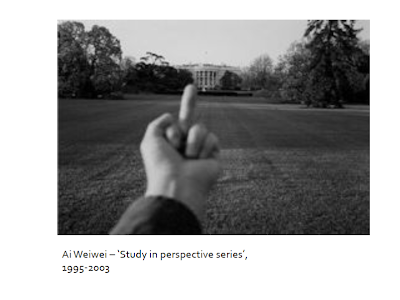Semiotics
Two Ronnies - Four Candles Scene
Meaning isn't guaranteed to what you say. The determination of the guy speaking was secure that he wouldn't be misinterpreted.
Defined Semiology
- a study of signs and systems
- language reduces to sign systems which creates image based signs which allows us to use these in understnading visual communication.
- established an imediate structures of the sign system :-
Signifier / Signified and Referent
Signifier - The image
Signified - The mental concept and translation of the image you make.
Reference - The actual thing or concept itself.
He also seperated the act of speech and the process of speaking from the system of language itself. This means that the process of speaking is a willful thing on our part that we decide what we want to say. However, language itself does not belong to use. It belongs to society.
Semiotics is a meta-language. It's a language of itself
Also signs work within systems and structures. What tells us what to think when we are faced with an image or word? The English language is a system, advertising is, photography, fashion. Diffferent signs in the systems mean what they do because there is an agreement of it.
What does this signify? go and cold?
How about now? For walkers it means salt and vinegar and cheese and onion but for other crisps its the other way round. Walkers have decided at some point that they would change the system completely
In actual fact there is no literal translation that the colour represents the flavour but it does in an agreed system.
Meaning is established in differentiation.
What these give us are levels of signification. Not everything works on a realistic and literal level. There are deeper levels. Roland Bart warns us to be very cautious of what we feel something may denote because it might just be part of a system and might conote something.
He looks at 'myths'. Naturalised over a long period of time so they go without saying. What myths are to roland bathes are a third order denotation. Something that bears no logical connection but been naturalised by society.
Examples of these would be wine and milk. Red wine in France is associated with intelligence over a long period of time. Milk particularly in the US is associated with wholesome, strength, freedom and liberty, when in actual fact there is no logical relation.
We use the word 'text' when referring to images semiotically. It could be anything.
Paradigm is a series of related signifiers or elements. We will consider how we place certain signifiers and meaning.
An example Boy/Man/Girl/Female. Replacing these words changes the connotation, history and meaning.
If we consider the Dolce and Gabbana advert. We have a classy gentleman. The bottle of perfume in the bottom right. The text and logo. In terms of the formal qualities. The composition. He is in the first third of the image and the information is in the bottom right corner.
If we were to talk about the marlboro advert. If we applied the perfume to that image. It changes to the perfume to be for a man's man! instead of a classy gentleman.
Metaphor can be used within images. An image of one thing can be used to represent something else of similar qualities.
A metonym is where a small part of the whole is used to describe the whole. Brings an idea of displacement.
For example, as a metonym, this could relate to politics when it's just an image of a hand and building.
Photo journalists used rhetorics when selecting photographs. Rhetoric is obvious. War is bad and does bad things to people.
Rhetoric is persuasion used in words.
A movie about him trying to make a movie. A meta-movie if you like.
Meta - a word that appears infront of words. Difficult to descibe what it means without examples.
Not just an artwork, but it's art that comments about art.
We arnt just concerned with how the images are composed but in fact how they come to represent. Not just images but objects, cultures and fashion.
Barthes himself could have been seen as a structuralist.
Post-structalism
<iframe src="http://player.vimeo.com/video/17431354?title=0&byline=0&portrait=0" width="500" height="419" frameborder="0" webkitAllowFullScreen mozallowfullscreen allowFullScreen></iframe> <p><a href="http://vimeo.com/17431354">ART THOUGHTZ: Post-Structuralism</a> from <a href="http://vimeo.com/hennessyyoungman">Hennessy Youngman</a> on <a href="http://vimeo.com">Vimeo</a>.</p>
By looking at the structures of meaning it is assuming the presence of a meaning. There is a meaning there. It can be described as logo centralism. Post structuralism aims to break down the structures. The things that are case aside and left behind.
Differance comes from the French to differ and to defer.
Deference is a lot more dangerous that difference. When you come across a word and look it up in a dictionary to find out the meaning but you notice other words from this that means you need to look them up to. Its a meaning that isn't your original meaning.
Looking at the piece of text above. He writes in such a complicated way which reflects the importance in interpretation.
Essentially what he is explaining is the process of deferring and differing all the time.
He says that most of our time our languages privilege things in opposition. Black, White, Male, Female.
Scary movie only has an existence because of the things that it refrences. Spaced does the exact same thing.
Reality has altered so much that the representations no longer represent anything that's real but itself.
The last quote on that slide - The precession of the simulacra - Most of our experience of reality is through images and representation. The news, adverts, tv, magazines.
What is the impact of these words, concepts and ideas within design?
how might we consider it for our own work?


































Leave your comment